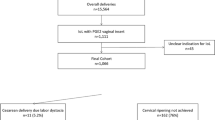Abstract
Purpose
To assess how some factors may influence the failure of labor induction.
Methods
We conducted a prospective observational study from January 2009 to December 2011 with 248 patients who were admitted to the Obstetrics Unit of Ferrara University for labor induction. We selected only patients with unfavorable characteristics such as nulliparity, maternal and gestational age, and Bishop score and specific obstetric conditions such as mild preeclampsia, isolated oligohydramnios, premature rupture membrane, gestational diabetes, and hypertension for the success of labor induction.
Results
The induction was carried out by rapid-release gel dinoprostone. 200 patients (80.6 %) delivered vaginally (Group A), while 48 (19.4 %) underwent a cesarean section (Group B). Maternal age was one independent significant variable (p = 0.01, OR 1.08) determining the risk of cesarean delivery. Patients affected by mild preeclampsia had a three times higher risk for cesarean section. Despite the several unfavorable characteristics of the patients, the cesarean section rate was comparable to that of the normal population.
Conclusions
Several factors and clinical conditions historically considered as negative predictors of induction result should be reassessed. The success of labor induction is determined by many maternal and fetal variables, which must all be taken into account to avoid unnecessary cesarean sections.
Similar content being viewed by others
References
Pandis GK, Papageorghiou AT, Ramanathan VG, et al. Preinduction sonographic measurement of cervical length in the prediction of successful induction of labor. Ultrasound Obstet Gynecol. 2001;18:623–8.
Gülmezoglu AM, Crowther CA, Middleton P, et al. Induction of labour for improving birth outcomes for women at or beyond term. Cochrane Database Syst Rev. 2012;13(6):CD004945.
Park KH, Hong JS, Ko JK, et al. Comparative study of induction of labor in nulliparous women with premature rupture of membranes at term compared to those with intact membranes: duration of labor and mode of delivery. J Obstet Gynaecol Res. 2006;32:482–8.
Tucker Edmonds B, Fager C, Srinivas S, et al. Predictors of cesarean delivery for periviable neonates. Obstet Gynecol. 2011;118:49–56.
Xenakis EM, Piper JM, Field N, et al. Preeclampsia: is induction of labor more successful? Obstet Gynecol. 1997;89:600–3.
Mozurkewich EL, Chilimigras JL, Berman DR, et al. Methods of induction of labour: a systematic review. BMC Pregnancy Childbirth. 2011;27(11):84.
Cheng YW, Sparks TN, Laros RK Jr, et al. Impending macrosomia: will induction of labour modify the risk of caesarean delivery? BJOG. 2012;119:402–9.
Jackson GL, Rawiki P, Sendelbach D, et al. Hospital course and short-term outcomes of term and late preterm neonates following exposure to prolonged rupture of membranes and/or chorioamnionitis. Pediatr Infect Dis J. 2012;31:89–90.
Sibai BM. Management of late preterm and early-term pregnancies complicated by mild gestational hypertension/pre-eclampsia. Semin Perinatol. 2011;35:292–6.
Chauhan SP, Sanderson M, Hendrix NW, et al. Perinatal outcome and amniotic fluid index in the antepartum and intrapartum periods: a meta-analysis. Am J Obstet Gynecol. 1999;181:1473–8.
Ek S, Andersson A, Johansson A, et al. Oligohydramnios in uncomplicated pregnancies beyond 40 completed weeks. A prospective, randomised, pilot study on maternal and neonatal outcomes. Fetal Diagn Ther. 2005;20:182–5.
Voxman EG, Tran S, Wing DA, et al. Low amniotic fluid index as a predictor of adverse perinatal outcome. J Perinatol. 2002;22:282–5.
Crane JM. Factors predicting labor induction success: a critical analysis. Clin Obstet Gynecol. 2006;49:573–84.
Sentilhes L, Bouet PE, Mezzadri M, et al. Assessment of the benefit-harm balance depending on gestationnal age to induce delivery for post-term pregnancies. J Gynecol Obstet Biol Reprod (Paris). 2011;40:747–66.
Kelly AJ, Malik S, Smith L, et al. Vaginal prostaglandin (PGE2 and PGF2a) for induction of labour at term. Cochrane Database Syst Rev. 2009;7:CD003101.
Sheiner E, Levy A, Katz M, et al. Gender does matter in perinatal medicine. Fetal Diagn Ther. 2004;19:366–9.
Reslan OM, Khalil RA. Molecular and vascular targets in the pathogenesis and management of the hypertension associated with preeclampsia. Cardiovasc Hematol Agents Med Chem. 2010;8:204–26.
Conflict of interest
The authors have no conflict of interest to declare.
Author information
Authors and Affiliations
Corresponding author
Rights and permissions
About this article
Cite this article
Giugliano, E., Cagnazzo, E., Milillo, V. et al. The Risk Factors for Failure of Labor Induction: A Cohort Study. J Obstet Gynecol India 64, 111–115 (2014). https://doi.org/10.1007/s13224-013-0486-z
Received:
Accepted:
Published:
Issue Date:
DOI: https://doi.org/10.1007/s13224-013-0486-z




